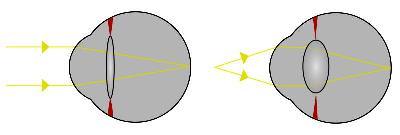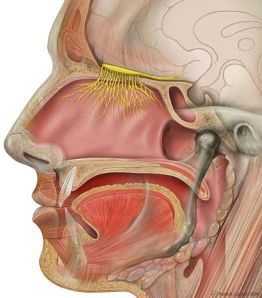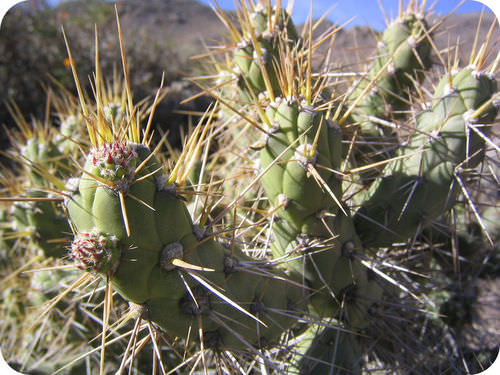8.6 感知感知
章节大纲
-
Name the five senses.
::说出五个感官的名字Hearing , sight , taste , touch, and smell . But how do they work? It all has to do with the .
::听觉、视觉、品味、触摸和嗅觉,但是它们如何运作?Sense Organs and Sensory Perception
::感官器官和感知Your senses are your body’s means of making sense of the information your nervous system receives from both inside your body and the outside world. Your senses enable you to adapt to changes in your environment and to survive. The sensory division of the is organized into highly developed sense organs , which are groups of tissues that work together in responding to a specific kind of physical stimulus , such as the stimulus in the Figure . The sense organs correspond to a defined region (or group of regions) within the brain where the nerve signals are received and interpreted. Your sense organs include your , ears, nose, mouth, and skin. They all have sensory receptors that are specific for certain stimuli. For example, the nose has sensory receptors for odors (smells). Sensory neurons send from sensory receptors to the . The brain then interprets the nerve impulses to form a response.
::您的感官是您身体感官的感官感官系统感知到您神经系统从身体和外部世界获得的信息的感官手段。您的感官使您能够适应环境的变化并生存下来。感官分裂被组织成高度发达的感官器官,这些器官是由组织组成的组合组成的,它们合力应对特定的物理刺激,例如图中的刺激。感官器官与大脑中接受和解释神经信号的确定区域(或区域组)相对应。你的感官器官包括你、耳朵、鼻子、嘴和皮肤。它们都有某些刺激特有的感官受体。例如,鼻部有嗅觉受体,有嗅觉受体。感官神经元从感官感应器向大脑发送。然后大脑将神经脉冲解释为一种反应。Can you smell these fresh, juicy oranges? Your senses of smell, taste, and sight are also important in developing an appetite. Just think of how appetizing these fruits would be if they were blue, crunchy, and smelled like burned toast.
::你能闻到这些新鲜的、多汁的橙子吗?你的嗅觉、味道和视力对于培养食欲也很重要。 想想这些水果如果是蓝色的、脆的和闻起来像烧烤的烤面包,那么开胃菜会如何。A sensory receptor is a or a group of cells that detect stimuli. Sensory receptors can be classified based on the type of stimuli to which they respond.
::感官受体是检测刺激性的一组或一组细胞,感官受体可根据其响应的刺激类型进行分类。-
Chemoreceptors
respond to chemical stimuli.
::乳房受体对化学刺激作出反应。 -
Mechanoreceptors
respond to mechanical stress or strain (movement).
::机械受体对机械压力或压力(运动)作出反应。 -
Thermoreceptors
respond to temperature changes.
::热接收器对温度变化作出反应。 -
Photoreceptors
respond to variations in light.
::光受体对光的变化作出反应。 -
Baroreceptors
respond to pressure.
::强压者对压力作出反应。
Specific areas of the brain interpret information from each sense organ. For example, regions of the occipital lobe interpret nerve impulses that come from the sensory receptors of the eyes, and regions of the temporal lobe interpret sensory information from the ears, as shown in Figure . It is generally agreed that there are at least seven different senses in humans. These are sight, sound, taste, smell, touch, balance , and body awareness (the sense of knowing where the regions of your body are located at any one time). At least two other senses, which humans do not have, are observed in other organisms . Examples include electroreception, the ability to detect electric fields, and magnetoreception, the ability to detect magnetic fields.
::大脑的特定区域解释来自每个感官器官的信息。例如,如图所示,叶区域解释来自眼睛感官受体的神经冲动,以及时间叶区域解释耳朵的感官信息。一般都认为,人类至少有7种不同的感官,它们是视觉、声音、口味、嗅觉、触摸、平衡和身体意识(知道身体区域在任何一个时刻的位置的感觉),在其他生物中至少观测到人类没有的另外两种感官,例如电感官、探测电场的能力、磁感应、探测磁场的能力。The entry of sensory nerves into the brain. Among other nerves, the sensory nerves for smell, sight, hearing, and taste (yellow structures) can be seen entering the skull. You can also see how the cerebrum, thalamus, cerebellum, and brain stem are nested within the skull.
::感官神经进入大脑。 除其他神经外, 嗅觉、 视觉、 听觉和口味( 黄色结构) 的感官神经可以被看到进入头骨。 您也可以看到脑、 脑、 脑、 脑、 脑、 脑和脑干是如何嵌入头骨的 。Sight
::视觉视觉Sight, or , describes the ability of the brain and eyes to detect certain wavelengths of electromagnetic radiation (light) and to interpret the image as "sight." Different receptors are responsible for the perception of color (the frequency of photons of light) and the perception of brightness (number of photons of light). Photoreceptors are found in the retina , as shown in Figure .
::视觉(或)描述大脑和眼睛探测电磁辐射(光)的某些波长和将图像解释为“视觉”的能力。不同的受体对颜色(光光光光光的频率)和亮度(光光光的光子数量)的感知负有责任。 光受体在视网膜中找到,如图所示。The eye is the organ that senses light and allows us to see.
::眼睛是能感知光的器官 使我们能看到Focusing light on the retina. This diagram shows how light from a distant source is bent by the stretched lens to strike the retina and how light from a closer source is bent even more sharply by the relaxed lens to strike the retina.
::聚焦视网膜的灯光。 这个图表显示了从远处源的灯光是如何被拉伸的透镜弯曲的来撞击视网膜的, 更近处源的灯光如何被放松的透镜弯得更尖锐地弯曲来撞击视网膜。The structure of the eye owes itself completely to the task of focusing light onto the retina—the light-sensitive, inner layer of the eye. First, light passes through a clear protective layer called the cornea , which is shown in Figure . Light then passes through the pupil, which is the opening in the iris, and into the interior of the eye. After passing through the pupil, the light travels through the lens , a transparent, biconvex structure that, along with the cornea, helps focus light on the retina. attached to the lens change the shape of the lens to bend the light rays so that they focus on the retina, as shown in Figure . Light hitting the retina causes chemical changes in the photosensitive cells of the retina. The products of this reaction trigger nerve impulses that travel to the brain along the optic nerve .
::眼部的结构完全归功于将光线聚焦在视网膜上的任务,即对视网膜的光敏度,眼睛的内层。首先,光通过一个称为角角的清晰保护层,图中显示。光然后穿过学生,即虹膜的开口,进入眼睛的内部。在通过学生后,光穿过镜头,一个透明、双convex的结构,连同角膜,有助于对视网膜的光亮度。附在镜片上的光线改变透镜的形状,以弯曲光线,以便聚焦视网膜,如图中所示。光击中视网膜导致视网膜光敏细胞的化学变化。这种反应的产物触发神经脉冲,沿着视网膜进入大脑。The retina has two forms of photosensitive cells that are important to vision—rods and cones. Rod cells are highly sensitive to light, which allows them to respond in dim light and dark conditions, but they cannot detect color. These are the cells that allow humans and other to see by moonlight or in a dimly lit room. This is why objects seem to have less color in darker conditions. Cone cells respond to different wavelengths of bright light to initiate a nerve impulse. They are also responsible for the sharpness of images. Cones do not respond well in poor light conditions, which is the reason why you see things in dim light as fuzzy shades of gray.
::视网膜有两种对视觉和锥形很重要的光敏细胞。 罗德细胞对光非常敏感, 允许它们以暗淡的光和暗的状态作出反应, 但是它们无法检测颜色。 这些是允许人类和其他人通过月光或暗暗的光室看到这些细胞。 这就是为什么在更暗的环境下, 物体的颜色似乎较少。 锥形细胞对不同的亮光波长作出反应, 以引发神经脉冲。 它们也对图像的锐利负责。 锥形细胞在恶劣的光条件下反应不好, 这就是为什么你把暗淡的光景看成灰色的阴影。Humans have three different types of cone cells that respond to different wavelengths of light—red, green, and blue. These cone cells contain a pigment that absorbs the energy from different wavelengths of light to initiate a nerve impulse. Activation of the visual pigments by certain wavelengths of light opens ion channels on the membrane of the cone or rod cell. This leads to an action potential that is carried by the millions of axons that make up the optic nerve to the visual centers of the brain. The brain integrates the nerve impulses from the cone cells and perceives the world in all the colors of the visual spectrum. A person who is colorblind has damaged or missing cones and is unable to perceive certain colors.
::人类有三种不同的锥形细胞,它们与不同波长的光-红、绿和蓝-光-光-光-光-蓝-相。锥形细胞含有一种色素,吸收不同波长光的能量以引发神经冲动。光-光-光-光-光-光-光-光-光-光-光-光-光-光-光-光-光-光-光-光-光-光-光-光-光-光-光-光-光-光-光-光-光-光-光-光-光-光-光-光-光-光-光。光-光-光-光-光-光-光-光-光-光-光。光-光-光-光-光-光-光-光-光-光-光-光-光-光-光-光-光-光-光-光-光-光-光-光-光-蓝-光-光-光-光-光-光-光-光-光-光-光-光-光-光-光-光-光-光-光-光-光-光-光-光-光-光-光-光-光-光-光-光-光-光-光-光-光-光-光-光-光-光-光-光-光-光-光-光-光-光-光-光-光-光-光-光-光-光-光-光-光-光-光-光-光-光-光-光-光-光-光-光-光-光-光-光-光-光-光-光-光-光-光-光-光-光-光-光-光-光-光-光-光-光-光-光-光-光-光-光-光-光-光-光-光-光-光-光-光-光-光-光-光-光-光-光-光-光-光-光-光-光-光-光-光-光-光-光-光-光-光-光-光-光-光-光-光-光-光-光-光-光-光-光-光-光-光-光Hearing
::听取听取听取听取听取听取听取听取听取听取听取听取听取听取听取听取Hearing is the sense of sound perception that results from the movement of tiny hair fibers in the inner ear. These hairs detect the motion of a membrane that vibrates in response to changes in air pressure. Sound can also be detected as vibrations that are conducted through the body. Sound wave frequencies that are too low or too high to be heard by the ear can be detected this way. Audible sound is sensed by the ear.
::听觉是听觉感知感知感,这是小发纤维在内耳移动的结果。 这些毛发检测到因气压变化而振动的膜的动静。 声音也可以被检测到通过身体进行的震动。 声音波频率太低或太高,听不到耳朵的声音可以这样探测到。 听觉能感知到声音。The ear is the organ that senses sound waves and allows us to hear. It also senses body position, so we can keep our balance.
::耳能感知声波和耳能让我们听到的器官。它也能感知身体的姿势,这样我们才能保持平衡。The folds of cartilage surrounding the outer ear canal are called the pinna. Sound waves are gathered by the pinna and channeled down the auditory canal , a tube-shaped opening of the ear that ends at the tympanic membrane, or eardrum .
::耳外运河周围的软体折折叠被称为针形。 声波由针形收集,通过声波传导到听觉运河,听觉运河是耳膜的管状开口,结束于舌膜或耳膜。Sound waves traveling through the ear canal hit the eardrum and cause it to vibrate. These vibrations travel across the air-filled middle ear cavity and through a group of three tiny, delicate : the hammer, the anvil, and the stirrup , which are shown in Figure . This group of bones amplifies and transfers the eardrum vibrations to another membrane called the oval window. The oval window separates the middle ear from the inner ear. The inner ear contains the cochlea .
::这些振动穿过空气填充的中耳腔,穿过三组细小而微妙的小组:锤子、和,图中显示。这组骨骼放大,将耳鼓振动转移到另一个叫做奥瓦尔窗口的膜上。奥瓦尔窗口将中耳与内耳隔开。内耳含有科赫莱亚。The cochlea is a coiled tube that is filled with a watery liquid that moves in response to the vibrations coming from the middle ear through the oval window. As the fluid moves, thousands of mechanoreceptors called hair cells bend, releasing neurotransmitters . The neurotransmitters cause action potentials in the of the auditory nerve . The action potential travels along the auditory nerve to structures in the brainstem, then to the thalamus, and then to the auditory centers of the brain in the temporal lobe of the cerebral cortex.
::科切莱亚是一种循环管,充斥着一种水液,它随着中耳的振动而从中耳穿过奥瓦尔窗口。随着液体的移动,数千个机械受体被称作发型细胞弯曲,释放神经传导器。神经传导器在听觉神经中产生行动潜力。行动潜力沿着听觉神经流向脑部的结构,然后流向Thalamus,然后流向大脑皮层时叶的大脑听力中心。A very strong movement of the fluid within the cochlea, caused by very loud noise, can kill hair cells. This is a common cause of partial hearing loss and is the reason why users of firearms or heavy machinery should wear earmuffs or earplugs. Destruction of the hair cells usually leads to permanent hearing loss; once destroyed, the hairs do not generally grow back.
::高声噪音导致科赫莱内液体的强烈移动,可能导致发型细胞死亡,这是造成部分听力损失的一个常见原因,也是火器或重型机械使用者应戴耳罩或耳塞的原因,摧毁发型细胞通常会导致永久性听力损失;一旦被摧毁,发型一般不会长回来。Balance and the Ears
::平衡和耳朵The ears are also fundamental for our sense of balance. The semicircular canals are three fluid-filled, interconnected tubes found inside each ear. They can be seen in Figure , directly above the cochlea. The canals are positioned at angles between 95 to 115 degrees relative to one another. The angles between the canals are not perpendicular, so movements of the head cause movement of fluid in two canals at the same time.
::耳也是我们平衡感的基础。 半圆形运河是每耳内发现的三个装满液体、相互关联的管。 它们可以在图中看到, 直接在科赫莱亚上方。 运河的位置在95至115度之间的角之间。 运河之间的角不是垂直的, 所以头部的移动会同时造成两条运河的液体流动。Each canal is filled with fluid called endolymph, and motion sensors with little hairs, called cilia , line each canal. Movement of the head and body cause the endolymph in the canals to move about. The hair cells sense the strength and direction of the fluid’s movement and send electrical signals to the cerebellum , which interprets the information and responds to help keep the body’s sense of balance. The interactions of the semicircular canals and the cerebellum allow the performer in Figure to do her act.
::每条运河都充斥着流体,叫做内分流体,还有运动传感器,有小毛毛,叫西里亚,每条运河线。 头部和身体的移动导致运河内的内分流体移动。 发型细胞感觉到流体运动的强度和方向,并将电讯发送到小脑,它解释信息,并作出反应,帮助保持身体的平衡感。 半循环管和小脑的相互作用使得图中的表演者能够做她的行为。Good balance required! This performer’s sense of balance is dependent on communication between her semicircular canals and her cerebellum.
::需要良好的平衡! 这个表演者的平衡感取决于她的半循环运河和小脑之间的沟通。When the sense of balance is interrupted it causes dizziness and nausea. Balance can be upset by an inner ear infection, a bad head cold, a sinus infection, or a number of other medical conditions. It can also be temporarily disturbed by rapid and repetitive movements such as riding on a merry-go-round or spinning around in a circle.
::当平衡感被打断时,它会导致头晕和恶心。 内耳感染、头痛、鼻腔感染或其他一些医疗状况会扰乱平衡,它也会被快速和重复的动作,如骑着旋转木马或环绕圆圈的动作暂时扰乱。Taste and Smell
::尝尝和闻闻Taste is one of the two main chemical senses—the other is smell. There are at least four types of taste receptors on the tongue. Taste stimuli from each receptor type send information to a different region of the brain. The four well-known receptors detect sweet, salt, sour, and bitter. The existence of a fifth receptor, for a sensation called umami , was confirmed in 2000. The umami receptor detects the amino acid glutamate, which causes a savory, “meaty” flavor in foods.
::味道是两种主要的化学感官之一,一种是嗅觉,另一种是舌头上至少有四种品味受体。每种受体的味道刺激将信息传递到大脑的不同区域。四种众所周知的受体检测到甜、盐、酸、酸和苦。2000年确认了第五个受体的存在,即一种叫做乌玛米的感官。 受体检测到氨基酸性营养素,这导致食物中一种香味、“美味”的口味。The location of taste buds. Most of the taste buds in the mouth are embedded in the papillae, which are the little bumps that cover the tongue. The deep groove (fissure) that runs down the center of the tongue in this photo is a common and perfectly normal condition.
::味蕾的位置。 口中的大部分味蕾都嵌在舌头上,这就是舌头上的小肿块。 这张照片中从舌头中间伸进的深处的曲折(fisure)是一种常见和完全正常的状况。The chemoreceptors of the mouth are the taste cells that are found in bundles called taste buds. Most of the taste buds are embedded within the tiny papillae, or “bumps,” that cover the tongue(see Figure ). Each receptor has a different way of detecting certain compounds and starting an action potential that alerts the brain. The compounds bind to receptors in the taste cells and stimulate neurons in the taste buds. The action potential moves along the facial nerves to the thalamus and then to the taste center of the cerebral cortex for interpretation by the brain. The tongue can also feel sensations that are not generally called tastes. These include temperature (hot or cold), coolness (as in “minty”), spiciness or hotness (peppery), and fattiness (greasy).
::口腔的乳酪感应器是被称作味蕾的捆包中发现的味觉细胞。 大部分味蕾嵌在覆盖舌头的细小小的里(见图 ) 。 每个受体都有不同的方法来检测某些化合物,并开始一种提醒大脑的动作潜力。 化合物与感应细胞中的受体结合,并在味蕾中刺激神经。 行动潜力会沿着面部神经转移到地中海,然后移到大脑皮层的口味中心,供大脑解释。 舌头也可以感觉到一般不称为品味的感觉。 其中包括温度( 热或冷 ) 、 凉爽( 如“ 小 ” ) 、 光滑或热( 发热) 、 肥( 肥) 。Smell is the other "chemical" sense. The chemoreceptors of smell are called olfactory receptors. About 40 million olfactory receptor neurons line the nasal passages. Different odor molecules bind to and excite specific olfactory receptors. The combination of excitatory signals from different receptors makes up what we identify as “smell.” Signals from the olfactory receptors travel along nerves to the olfactory bulb in the brain where they then move to the smell center in the frontal lobe of the cerebral cortex. Olfactory receptor neurons in the nose differ from most other neurons in that they die and regenerate on a regular basis. A dog’s keen sense of smell is due to the large areas of its nasal passages that are covered by olfactory receptors and the large number of nerves that bring nerve impulses from the receptors to its brain. For example, the area in which olfactory receptors are located inside the human nose (called the olfactory epithelium), which is shown in Figure , measures about 12 cm 2 . The olfactory epithelium of some dogs’ noses can measure about 150 cm 2 !
::另一种“ 化学” 感官是另一种“ 化学” 感官。 嗅觉的发泡器叫做嗅觉受体。 大约4000万个嗅觉受体神经神经神经的嗅觉。 不同的嗅觉分子与不同的嗅觉受体结合,并且刺激特定的嗅觉受体。 不同受体的刺激信号结合在一起,形成了我们所认定的“ 嗅觉感应器 ” 。 嗅觉受体的信号随神经传到大脑的嗅觉泡,然后移动到大脑皮层前部的嗅觉中心。 鼻部的奥氏感应受体神经神经与大多数其他神经神经有不同,因为它们死亡和再生。 狗的嗅觉感应感应是由于其鼻孔的广大区域被嗅觉感应器所覆盖。 将神经感应器的神经冲动带到大脑。 例如, 鼻部前部的嗅觉感应感应器位于该区。 在人类鼻部的150个测量器内。 。Have you ever noticed that you cannot taste anything when your nose is stuffed up? That is because your senses of smell and taste are closely linked. This is due to the fact that your nasal cavity , located behind the nostrils, connects to your mouth at the back of your throat, as shown in Figure . Your olfactory receptors and taste receptors both contribute to the flavor of food . Your tongue can only tell among a few different types of taste, while your nose can distinguish between hundreds of smells, even if only in tiny amounts. The combination of your tongue's taste information and your nose's smell information is used by the brain to determine taste.
::你难道没有注意到吗?当鼻子塞满的时候,你什么都不能吃吗?这是因为你的嗅觉和口味是紧密相连的。这是因为你的鼻腔在鼻孔后面,如图所示,在喉咙后面与你的嘴相连。你的嗅觉受体和口味受体都有助于食物的口味。你的舌头只能在几种不同的口味中分辨出来,而你的鼻子可以区分成百上千的气味,即使数量很小。你的舌头的口腔和鼻孔的嗅觉信息被大脑用来决定口味。The location of olfactory nerves. Olfactory receptors and their associated nerves (yellow) line the top of the nasal passages. Nerve messages from the receptors are sent to the brain to be interpreted as certain smells.
::嗅觉神经的定位。 循环受体及其相关的神经( 黄线) 排在鼻腔通道的顶部。 感应器的神经信息被发送到大脑, 被解释为一定的气味 。Touch, Pressure, and Pain
::触摸、压力和疼痛Touch is the sense of pressure perception, which is generally felt in the skin. There are a variety of pressure receptors that respond to variations in pressure and tension. Mechanoreceptors are most numerous on the tongue, lips, face, palms (including fingertips), and soles of the feet.
::触摸是压力感知感知感知感知感知感知感知感知感知感知感知感知感知感知感知感知感知感知感知感知感知感知感知感知感知感知感知感知感知感知感知感知感知感知感知感知感知感知感知感知感知感知感知感知感知感知感知感知感知感知感知感知感知感知感知感知感知感知感知感知感知感知感知感知感知感知感知感知知知知知知知知知知知知知知知知知知知知知知知知知知知知知知知知知知知知知知知知知知知知知知知知知知知感知感知感知知知知知感知感知感知知知感知知知知知知知感知知知知知知知知知感知知感知知知知知知知知知知知感知知知感知知感知知知知知知知知知知知知知知知知知知知知知知知知知知知知知知知知知知知知知知知知知知知知知知知知知知知知知知知知知知知知知知知知知知知知知知知知知知知知知知知知知知知知知知知知知知知知知知感知知知知知知知知知知知知知知知知知知知知知知知知知知知知知知知知知知知知知知知知知知知知知知知知知知知知知知知知知知知知知知知知知知知知知知知知知知知知知知知知知知知知知知知知知知知知知知知知知知知知知知知知知知知知知知知知知知知知知知知知知知知知知知知知知知知知知知知知知知知知知知知知知知知知知知知知知知知知知知知知知知知知知There are several types of pain receptors, called nociceptors, which respond to potentially damaging stimuli. They are mostly found in the external parts of the body, such as the skin, cornea, and mucous membranes, but are also found in muscles, , and some internal organs . Nociceptors are classified according to the stimuli to which they respond: thermal, mechanical, or chemical. But some receptors respond to many different damaging stimuli of a chemical, thermal, or mechanical nature. Thermal receptors are activated by potentially harmful heat or cold (temperatures above 45°C (113°F) and below 5°C (41°F)). Mechanical receptors respond to excess pressure, squeezing, or bending—these are the types of painful stimuli that a cactus, such as the one in Figure , would cause. Together, these nociceptors allow the organism to feel pain in response to damaging pressure, excessive heat, excessive cold, and a range of chemicals, the majority of which are damaging to the tissue surrounding the nociceptor.
::有几种类型的疼痛受体,称为无感应器,对可能造成伤害的刺激作用作出反应,它们大多存在于身体的外部部位,如皮肤、角膜和粘膜膜,但也存在于肌肉和一些内脏中。受体按其反应的刺激作用进行分类:热、机械或化学。但有些受体对化学、热或机械性质的多种不同破坏性刺激作出反应。热受体因潜在的有害热或冷(温度高于45°C(113°F)和5°C(41°F))而起动。机械受体受体因应超压、挤压或弯曲而起作用——这些是像图中图中图中图中图中图中图中图中图中图中所示的受体等一种痛苦刺激作用。加在一起,这些受体允许生物因受损害的压力、过度热、过热、过冷和一系列化学物质而感到疼痛,这些受体大部分对周围的组织造成伤害。Mechanical pain receptors in your skin would warn you if you got too close to this prickly cactus.
::皮肤上的机械疼痛受体 会警告你 如果你太接近这个刺痛的仙人掌Summary
::摘要-
In addition to the five senses of sight, smell, touch, taste, and hearing, there are also the two senses of balance and body awareness.
::除了视觉、嗅觉、触摸、品味和听觉的五种感知之外,还有两种平衡感和身体意识。 -
Different types of sensory receptors serve to change perception into nerve impulses.
::不同类型的感官受体有助于将感知改变为神经冲动。
Review
::回顾-
What is a sense organ?
::什么是感官器官? -
For each of the five senses, explain how the perception becomes nerve impulses.
::对于这五种感官中的每一种 解释一下感觉是如何变成神经冲动的
Explore More
::探索更多Use the video above to answer the following questions:
::使用以上视频回答下列问题:-
What is synesthesia?
::什么是合成? -
What examples of synesthesia are given throughout this video?
::这段影片中,有哪些合成的例子? -
What is true in all synesthetes?
::在所有的协同关系中,什么是真实的? -
Why does synesthesia occur?
::为什么会发生合成麻醉?
-
Chemoreceptors
respond to chemical stimuli.









